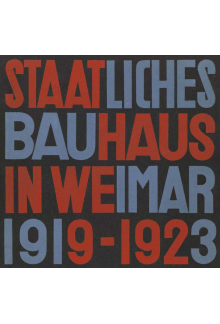- Titulinis
- Meno ir laisvalaikio literatūra
- Architektūra, dizainas
- Grafinis dizainas
- Staatliches Bauhaus in Weimar 1919-1923 (State Bauhaus in Weimar 1919-1923)
Staatliches Bauhaus in Weimar 1919-1923 (State Bauhaus in Weimar 1919-1923)
Balsavo 0
ISBN: 9783037786239
Leidimo metai: 2019
Puslapių skaičius: 226
Formatas: Kieti viršeliai
Formatas: 24.8×24.5
Leidimo metai: 2019
Puslapių skaičius: 226
Formatas: Kieti viršeliai
Formatas: 24.8×24.5
Kaina:
Šių parametrų produkto neturime
Likutis pakankamas
Iš leidyklos gausime per 3-5 savaitės. Galimas vėlavimas
Turime sandėlyje. Pristatymas Lietuvoje 1-4 d.d.
Iš leidyklos gausime per 3-5 savaitės. Galimas vėlavimas
Pristatymo sąlygos
Aprašymas
In 1919, the state art school in Weimar was reopened under the direction of Walter Gropius, with a radical new teaching approach and under the new name Bauhaus. Four years would pass until the first exhibition, which presented a novel approach to art to an enthusiastic public and spread the school's ideas throughout the world.The catalogue "Staatliches Bauhaus in Weimar 1919-1923" was published in 1923 to accompany this first public showcase. This catalogue of its transdisciplinary oeuvre put the Bauhaus idea on paper for the first time and gave an idea of its potential. Featuring numerous projects, it also describes the theoretical doctrines of Paul Klee, Wassily Kandinsky, and Gertrud Grunow, thus conveying the teaching methods applied in the various workshops. Gropius's preface explains the structure of the state-run Bauhaus and introduces its unique reform program, which called for and taught the unity of technology and art. Illustrations from the various workshops show projects by students whose connection with the Bauhaus is still largely unexplored today.With the original layout by Laszlo Moholy-Nagy and a cover designed by Herbert Bayer, the book represents an important testimony to the legendary avant-garde movement, shedding light on the work and aspirations of the Bauhaus from its earliest days.The commentary accompanying this facsimile edition places this momentous publication, rare and long out of print, in a historical context, documenting the Bauhaus from the initial idea to the standing it would attain as a preeminent school of art and design.The German facsimile is accompanied by the first full English translation of the catalogue, making it accessible to an international audience.
Atsiliepimai (0)
Palikite atsiliepimą

